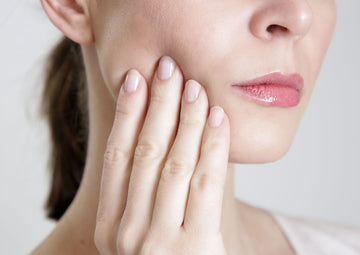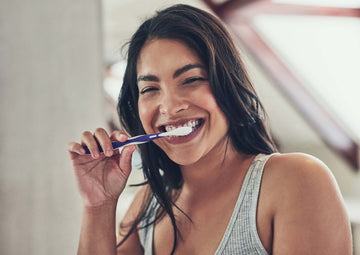

Looking for ways to brighten up your smile? Odds are you’ve come across teeth whitening products and you have several questions: How do they work? Is it safe? Is it permanent?
If you’ve done a deep dive and Googled all of your questions, you’ve likely come across some contradicting results. There are a lot of misconceptions around the process of whitening teeth.
As an oral wellness company, we’re here to set the record straight. We cover 25 teeth whitening facts and statistics that will put your mind at ease and dispel any myths you’ve come across. If you think you already know everything there is to know, jump to our infographic below to quiz yourself.
Fact #1: Teeth Aren't Naturally White.

Yup, you heard that right! Our pearly whites aren’t naturally bright white. So having white teeth doesn’t necessarily mean they are healthy. In fact, the dentin below your teeth is actually dark yellow — causing the surface to appear a light yellow or grey color.
Fact #2: White Teeth Don't Mean Healthy Teeth.
Because teeth aren’t naturally white, having light yellow or light grey teeth could mean they are perfectly healthy! However, if your teeth are discolored because of staining or plaque build-up, that’s when it becomes unhealthy. For example, drinking acidic and sugary drinks — such as soda — can erode your tooth enamel and cause the dentin to be exposed, resulting in a darker yellow shade on your teeth.
Fact #3: Your Teeth Change Color as You Age.

Our teeth endure a ton of wear and tear over the course of our lives. Between chewing, grinding, sipping, and gravity, our teeth will begin to weaken over time. Age can also change the color of your teeth to darker, yellow shades. You’ll likely see changes to the color, shape, and position of your teeth in your late 30s or 40s. This is normal.
Fact #4: Teeth Whitening is Safe.
There are several theories online that claim teeth whitening can damage teeth. However, the truth is much more complicated than that. Teeth whitening — when used the right way — is typically safe.
The side effects will depend largely on the type of method you choose. Natural at-home remedies — such as oil pulling and baking soda — or whitening products with peroxide can irritate teeth. If you’re concerned, you should always talk to your dentist to see if it is safe for you.
Fact #5: Certain Foods and Drinks Stain Teeth.

A common cause of yellow-stained teeth is the type of foods and drinks you consume. Foods and drinks that are acidic, dark or bright colored, filled with tannins (hello, wine!), and sugary are common culprits of yellow-stained teeth.
On the bright side, there are certain foods that can whiten teeth! Foods that are crunchy, full of fiber and calcium, and rich in vitamin C can all help break up plaque and fight off stain-causing bacteria.
Fact #6: Crowns, Veneers, and Fillings Cannot be Whitened.
If you currently have crowns, veneers, or other fillings and you go to get your teeth whitened, you’ll end up with uneven colored teeth. Teeth whitening products are designed to remove stains on the enamel. Crowns, fillings, and veneers are not made of enamel — they’re made of inorganic materials that are not susceptible to teeth whitening products. If you don’t have fillings, crowns, or veneers yet, but plan to get them soon, make sure to get your teeth whitened first.
Fact #7: Teeth Whitening and Teeth Cleaning are Very Different.

Teeth whitening and teeth cleaning are both dental procedures, but they’re not the same. The purpose of teeth cleaning is to remove any plaque or bacteria from the surface of your teeth in order to prevent gum disease and tooth decay. Teeth cleaning is done by dentists. It’s an important part of oral hygiene and should be done on a regular basis.
The main goal of teeth whitening is to remove stains for cosmetic purposes. Teeth whitening can be done at home or at your dentist’s office. It’s not something dentists recommend for typical oral hygiene — it’s solely for cosmetic reasons.
Fact #8: You Shouldn't Whiten Teeth if You Have Braces.
Whitening teeth with braces is possible, however, it’s not recommended. If you choose to get your teeth whitened with braces you may end up with discolored teeth once your braces come off. The teeth whitening solution will whiten your enamel, but it won’t whiten the portion of your teeth covered by braces. Teeth whitening products also have the ability to loosen the braces and glue, so it should be avoided.
Fact #9: Laser Teeth Whitening is the Most Expensive.

There several types of teeth whitening solutions, however, laser teeth whitening is the most expensive. Laser teeth whitening is an in-office dental procedure that is not typically covered by insurance. It’s about $1,500 compared to at-home teeth whitening, which costs $100 or less.
Fact #10: Teeth Whitening Doesn’t Last Forever.
A common misconception around teeth whitening is that it’s permanent. This is not true. While you will see great results, the results will eventually fade and you’ll need to go back in or apply another treatment.
Depending on the method you choose, results can last anywhere from four months to three years. This is also contingent on your diet. If you’re consuming foods and drinks that stain teeth, your results will fade quicker and another whitening treatment or touch-up will likely be needed sooner.
Fact #11: The Best Time to Whiten Teeth is Right Before Bed.

The best time to whiten teeth — especially if you’re whitening your teeth at home — is right before bed. This is because you’re unlikely to consume any foods or drinks for the seven to eight hours that you’re asleep.
After whitening, your teeth become porous, causing them to absorb the colors of foods and drinks easier and making them more susceptible to stains. Using a whitening treatment right before bed allows enough time for your teeth to return to their normal state.
Fact #12: Teeth Whitening Doesn’t Work on All Teeth.
As we mentioned before, teeth whitening will not work on teeth that have caps, fillings, crowns, or veneers. A dark tooth (a tooth that is gray or brown) may or may not be able to be treated. If the tooth is alive, it can be whitened with a powerful teeth whitening gel. If the tooth is dead, treatment is more difficult and not recommended.
If the discoloration on your teeth is caused by medications, injury, or health-related issues — like exposed gums or decaying enamel — your teeth most likely won’t be able to be whitened. Age can also have an effect on the ability to whiten teeth — older teeth are less prone to whitening. Teeth whitening works best on extrinsic stains (stains on the outside of your teeth). Intrinsic stains (stains on the inside of the tooth) caused by age or medications, generally can’t be whitened without some type of procedure or replacement. To make sure teeth whitening will work for you, always talk to your dentist beforehand.
Fact #14: Mouthwash is Not Effective at Whitening Teeth.

Some mouthwashes can help remove stains from teeth. However, it’s not the most effective whitening method. Mouthwashes are better suited for treating bad breath. If you’re looking for fast, long-lasting results, you should try professional teeth whitening or at-home teeth whitening strips or whitening kits.
Fact #13: You May Experience Tooth Sensitivity After Whitening.
A common concern among many people is whether or not teeth whitening will hurt their teeth. The most common side effect of the teeth whitening process is tooth sensitivity. Dental-grade bleaching agents are powerful. They break through the tooth enamel to whiten inside the tooth for the best results. In some cases, the bleaching agent can hit a nerve ending — causing tooth sensitivity. This is temporary and does not require any sort of medical treatment.
Fact #15: You Don’t Need to Go to a Dentist to Whiten Teeth.

Another common misconception is that you need to go into a dentist’s office to see the best results. There are now many products out there — like Auraglow — that will give you professional-grade whitening results from the comfort of your own home. Every product we make at Auraglow is made with professional-quality ingredients you would find at any dentist’s office, for a fraction of the price.
Teeth Whitening and Dental Health Statistics
Teeth whitening is becoming increasingly popular. If you’re still not convinced, check out the whitening statistics we’ve rounded up below.
- According to a survey conducted by Kelton Global for the AACD, 48% of American adults believe a smile is the most memorable feature of a person after meeting them for the first time (AACD).
- 25% of people with a flawed smile are believed to be less confident (AACD).
- 37 million Americans used tooth whiteners in 2020 (Statista).
- Cosmetic tooth bleaching was an over $3.1 million global industry in 2016 (Businesswire).
- The teeth whitening market has the potential to grow by over $840 million between 2020 and 2024 (Technavio).
- The average cost of in-office teeth whitening is $650 (Bankrate).
- At-home teeth whitening products cost about $500 less on average than in-office teeth whitening (Auraglow).
- Over 1 in 4 adults in the U.S. have untreated tooth decay (CDC).
- 46% of all adults aged 30 years or older show signs of gum disease (NIH).
- Oral health diseases affect almost 3.5 billion people (WHO).
Smiles are important to a lot of people. They can help give us the confidence we need to land that new job and they can be the reason we feel a connection to someone. Teeth whitening can help people regain that confidence and embody the unique smile that they have.
At Auraglow, we know that every smile is different and we’re committed to creating the right products for your smile. From whitening pens that you can use on the go to powerful teeth whitening kits that give professional dental results in just one treatment, we’ve got you covered! We believe that a bright smile can help you feel happy and healthy, so we created products that do just that.





